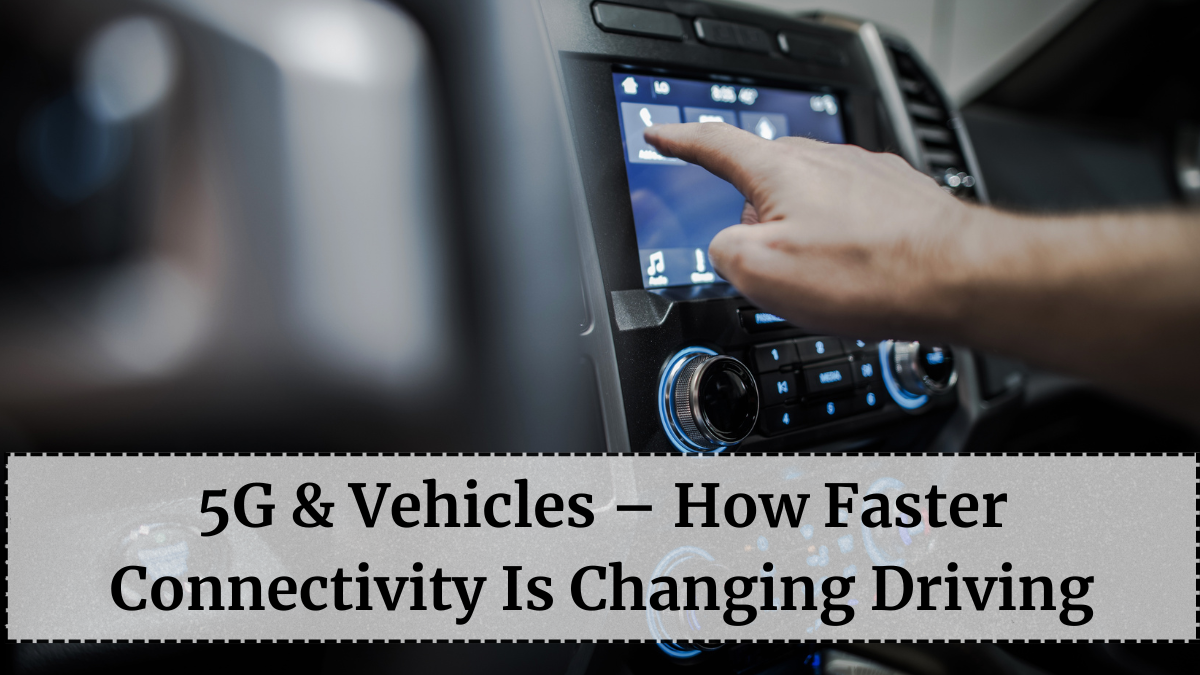The arrival of 5G technology is revolutionizing how cars communicate, drive, and interact with the world around them. In 2025, vehicles are no longer isolated machines — they’re intelligent, connected systems that exchange information with roads, infrastructure, and other vehicles in real time.
This ultra-fast communication network is not just improving entertainment or navigation — it’s enabling the foundation for autonomous driving, predictive safety, and cloud-powered updates. As cars evolve into smart mobility devices, 5G is the invisible force powering this transformation.

What Is 5G in Automotive Technology?
The Core of Connected Mobility
5G stands for the fifth generation of mobile networks, capable of transferring massive amounts of data at lightning speed with extremely low latency. While 4G laid the groundwork for connected infotainment, 5G brings real-time responsiveness — essential for vehicles to process millions of signals every second.
How It Works in Cars
Every modern car comes with sensors, cameras, and digital control units. With 5G integration, these systems can communicate directly with external sources such as traffic signals, nearby vehicles, and cloud-based data centers. This real-time exchange helps predict road conditions, prevent collisions, and even reroute vehicles during emergencies.
The Benefits of 5G-Enabled Cars
Real-Time Communication (V2X Technology)
One of the biggest breakthroughs of 5G is Vehicle-to-Everything (V2X) communication. It allows cars to interact with:
-
Other vehicles (V2V) – sharing position, speed, and direction to avoid crashes.
-
Infrastructure (V2I) – receiving signals from traffic lights or road sensors.
-
Pedestrians (V2P) – detecting people using connected smartphones or wearables.
This instant exchange of information helps reduce accidents, manage traffic flow, and make roads smarter and safer.
Enhanced Autonomous Driving
Autonomous and semi-autonomous cars rely heavily on high-speed data exchange. With 5G, they can now process and respond to dynamic road conditions in milliseconds, allowing faster decision-making and safer navigation.
Smart Navigation and Traffic Management
With 5G connectivity, vehicles can access real-time map updates, dynamic route optimization, and AI-driven traffic management systems. This ensures smoother drives, lower congestion, and better fuel efficiency — especially in large cities like Delhi, Mumbai, and Bengaluru.
Over-the-Air (OTA) Upgrades
Gone are the days of manual software updates. 5G makes OTA updates faster and more reliable, enabling automakers to deliver instant improvements to performance, safety systems, or infotainment — directly through cloud servers.
Next-Gen Infotainment and Entertainment
Passengers will experience ultra-fast streaming, cloud gaming, and real-time AR navigation thanks to 5G’s low latency. Multi-screen entertainment systems, AI voice assistants, and HD video calls are now standard in many 2025 models.
How 5G Is Transforming the Automotive Industry
Collaboration Between Automakers and Tech Giants
The development of 5G cars involves close collaboration between car manufacturers and telecom leaders. Partnerships such as Hyundai with Qualcomm, BMW with Ericsson, and Tata Motors with Jio are driving large-scale deployment of connected mobility solutions in India and worldwide.
Smart Cities and Connected Infrastructure
5G vehicles are the backbone of smart cities, where traffic lights, toll systems, and even street lamps communicate with vehicles. This interconnected ecosystem helps optimize traffic flow, reduce emissions, and improve emergency response times.
AI and Edge Computing Integration
5G enables edge computing, which allows data to be processed locally rather than relying solely on cloud servers. This ensures faster reaction times for critical features like automatic braking, collision alerts, and adaptive cruise control.
Challenges in 5G Vehicle Adoption
While the potential is massive, India and many developing nations still face barriers:
-
Limited 5G Coverage: Network expansion in rural areas remains slow.
-
High Implementation Costs: 5G hardware and infrastructure are expensive for automakers.
-
Cybersecurity Concerns: With increased connectivity comes increased vulnerability to data breaches and hacking.
Despite these challenges, the shift toward connected mobility is unstoppable, and 5G will be the driving force behind this transformation.
The Future of 5G in Cars
By 2026, experts predict that over 70% of new vehicles will be equipped with 5G connectivity. Cars will become smarter, not just through automation but through collaboration — communicating with the world around them to prevent accidents, reduce pollution, and create seamless transport experiences.
The dream of a fully connected, autonomous transportation ecosystem is no longer distant. With 5G, every journey becomes faster, safer, and more intelligent.
FAQs
What is the role of 5G in modern cars?
5G enables faster data transfer, allowing cars to communicate with other vehicles and infrastructure for safer, smarter driving.
How does 5G improve road safety?
Through Vehicle-to-Everything (V2X) communication, cars can instantly share road information to prevent accidents and manage traffic flow.
Do all new cars support 5G in 2025?
Most premium and mid-range cars launched in 2025 support 5G connectivity, while lower segments are expected to follow by 2026–2027.
Is 5G necessary for autonomous driving?
Yes, 5G provides the ultra-low latency required for real-time decision-making, which is essential for self-driving and AI-powered vehicles.
Will 5G cars work in rural India?
Currently, 5G coverage is stronger in urban areas. However, telecom companies are expanding networks rapidly to reach semi-urban and highway regions by 2026.
Click here to know more.
